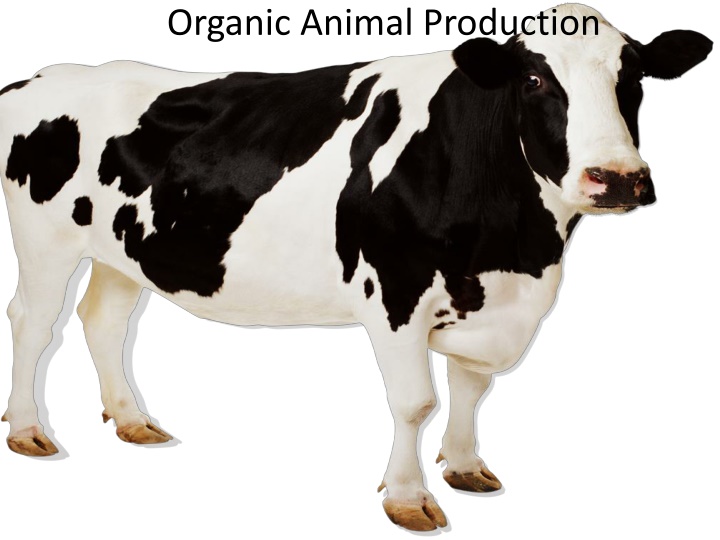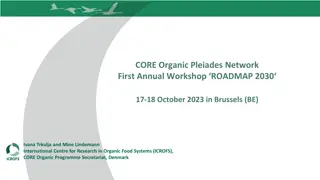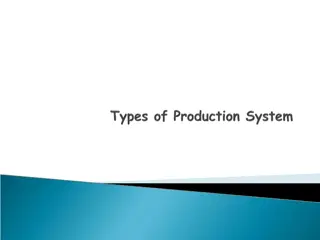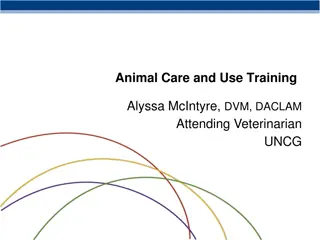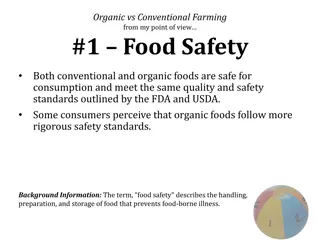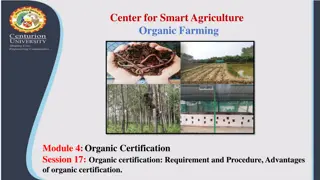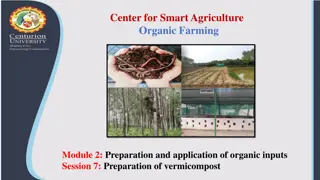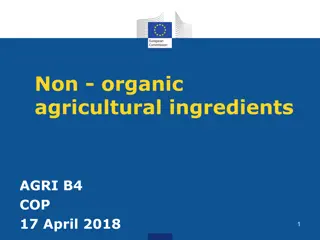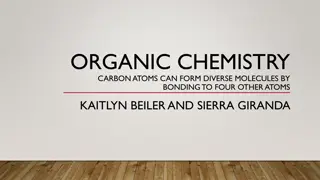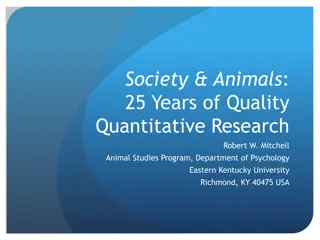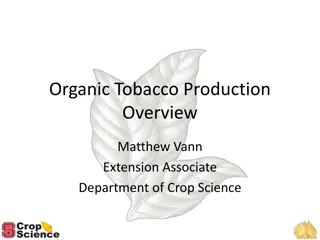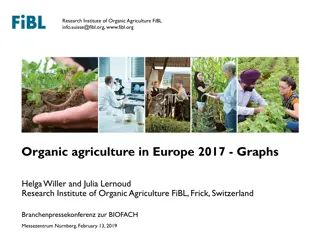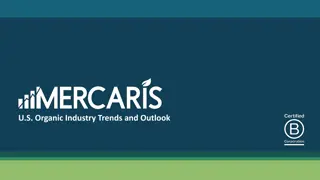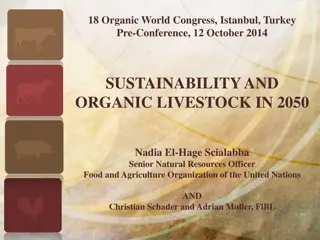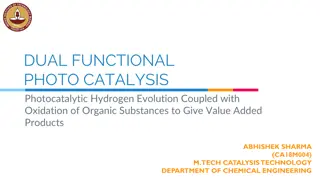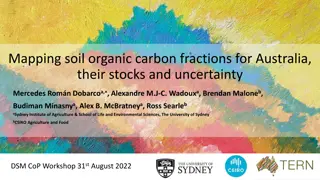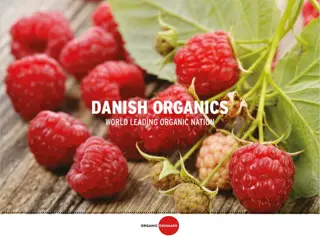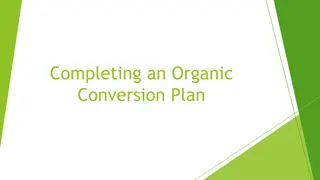Organic Animal Production in the US: Insights and Statistics
Organic animal production in the US involves raising livestock and poultry through natural practices without antibiotics or hormones. Animals are fed organic feed and have access to outdoor spaces to mimic natural behavior. Statistically, over 5 million acres of land are certified for organic animal farming, including a variety of livestock such as beef cows, hogs, sheep, and poultry. This sustainable approach promotes a healthy environment and high-quality organic products for consumers.
Download Presentation

Please find below an Image/Link to download the presentation.
The content on the website is provided AS IS for your information and personal use only. It may not be sold, licensed, or shared on other websites without obtaining consent from the author.If you encounter any issues during the download, it is possible that the publisher has removed the file from their server.
You are allowed to download the files provided on this website for personal or commercial use, subject to the condition that they are used lawfully. All files are the property of their respective owners.
The content on the website is provided AS IS for your information and personal use only. It may not be sold, licensed, or shared on other websites without obtaining consent from the author.
E N D
Presentation Transcript
Organic Animal Production Jude Maul Nick Marvell Heather Darby Patricia Milner
Organic Animal Production Introduction, national and local agroecosystem perspective: Jude Maul Sustainable Agriculture Systems Lab, USDA, Beltsville On the ground perspective, Maryland mixed production systems: Nick Marvell Nick s Organic Farm, Maryland Research and northeastern perspective, Vermont and New England Extension and research in dairy systems. Heather Darby University of Vermont, Northwestern crops and soil program. Comments from the gallery: Manure handling and the concerns in animal/veg. crop production systems. Patricia Milner
Animals, Organic or not are a value added product Total US Production Livestock and poultry account for over half of U.S. agricultural cash receipts, often exceeding $100 billion per year. How are organic livestock and poultry raised? Organic meat, dairy products, and eggs are produced from animals that are fed organic Feed and allowed access to the outdoors. They must be kept in living conditions that emulate the natural behavior of the animals. Ruminants must have access to pasture. Organic livestock and poultry may not be give antibiotics, hormones, or medicationsin the absence of illness; however, they may be vaccinated against disease. Parasiticide use is strictly regulated. Livestock diseases And parasites are controlled primarily through preventative measures such as rotational grazing, balanced diet, sanitary housing, and stress reduction.
Organic Animal Production in the US acres 5,383,119 2,298,130 3,084,989 U.S. certified farmland: Total Pasture/rangeland Cropland Source: U.S. Department of Agriculture, Agricultural Marketing Service.
Organic Animal Production in the US acres 5,383,119 2,298,130 3,084,989 U.S. certified farmland: Total Pasture/rangeland Cropland U.S. certified animals: Livestock Beef cows Milk cows Other cows 1/ Hogs & pigs Sheep and lambs Total Livestock 106,181 254,771 113,114 12,373 5,914 492,353 Source: U.S. Department of Agriculture, Agricultural Marketing Service.
Organic Animal Production in the US acres 5,383,119 2,298,130 3,084,989 U.S. certified farmland: Total Pasture/rangeland Cropland U.S. certified animals: Livestock Beef cows Milk cows Other cows 1/ Hogs & pigs Sheep and lambs Total Livestock 106,181 254,771 113,114 12,373 5,914 492,353 Poultry Layer hens Broilers Turkeys Other/unclassified Total Poultry 6,663,278 28,644,354 504,315 1,216,295 37,028,242 Source: U.S. Department of Agriculture, Agricultural Marketing Service. Total certified operations* 12,880
Animals, Organic or not are a value added product Total US Production Livestock and poultry account for over half of U.S. agricultural cash receipts, often exceeding $100 billion per year.
Animals, Organic or not are a value added product Total US Production Livestock and poultry account for over half of U.S. agricultural cash receipts, often exceeding $100 billion per year. Estimated U.S. sales of organic and total fluid milk products, monthly and annual, 2006-13 Novem Decem Year January February March April Sales Sales Sales Sales Sales Sales Sales Sales Sales (Mil lbs) lbs) lbs) lbs) May June July August Sept. October ber ber Sales Sales Sales (Mil lbs) lbs) (Mil (Mil (Mil (Mil lbs) (Mil lbs) (Mil lbs) (Mil lbs) (Mil lbs) (Mil (Mil lbs) Total Organic Milk Products 2013 Total Fluid Milk Products Adj.* Organic milk/Total milk (%) 189 162 186 191 195 179 189 195 192 194 193 199 2013 4,572 4,120 4,386 4,337 4,347 3,859 4,068 4,350 4,326 4,496 4,390 4,394 2013 4.13 3.93 4.24 4.40 4.49 4.64 4.65 4.48 4.44 4.31 4.40 4.53 Source: U.S. Department of Agriculture, Agricultural Marketing Service.
Animals, Organic or not are a value added product Total US Production Livestock and poultry account for over half of U.S. agricultural cash receipts, often exceeding $100 billion per year. Prices paid by first receiver for organic and conventional eggs 2004-08 Year Jan. Feb. Mar. Apr. May Dollars per dozen/carton Organic price 2004 2.30 2.26 2.25 2.25 2.25 2005 2.34 2.34 2.34 2.34 2.34 2006 2.34 2.34 2.34 2.34 2.34 2007 2.34 2.36 2.37 2.37 2.37 2008 2.37 2.37 2.37 2.37 2.37 June July Aug. Sep. Oct. Nov. Dec. 2.30 2.34 2.34 2.37 2.78 2.34 2.34 2.34 2.37 2.78 2.34 2.34 2.34 2.37 2.78 2.34 2.34 2.34 2.37 2.78 2.34 2.34 2.34 2.37 2.78 2.34 2.34 2.34 2.37 2.78 2.34 2.34 2.34 2.37 2.78 Conventional price 2004 2005 2006 2007 2008 1.04 0.53 0.72 0.91 1.50 1.02 0.62 0.52 1.01 1.48 1.14 0.53 0.69 0.93 1.55 0.83 0.46 0.62 0.84 1.25 0.65 0.48 0.43 0.91 0.98 0.69 0.43 0.60 0.76 1.12 0.63 0.55 0.44 1.04 1.01 0.58 0.64 0.62 1.03 1.07 0.54 0.67 0.60 1.22 1.13 0.51 0.69 0.58 1.07 1.11 0.62 0.73 0.85 1.31 1.16 0.68 0.71 0.91 1.53 1.14 Source: U.S. Department of Agriculture, Agricultural Marketing Service.
Organic Animal Production Issues in Organic Animal Production
Organic Animal Production Issues in Organic Animal Production were managed under continuous organic management from the last third of gestation or at hatching. Animal Origin: Livestock must originate from animals that
Organic Animal Production Issues in Organic Animal Production were managed under continuous organic management from the last third of gestation or at hatching. Animal Origin: Livestock must originate from animals that Feedstuffs that are produced according to organic standards. Livestock Feed: Livestock rations must be limited to
Organic Animal Production Issues in Organic Animal Production were managed under continuous organic management from the last third of gestation or at hatching. Animal Origin: Livestock must originate from animals that Feedstuffs that are produced according to organic standards. Livestock Feed: Livestock rations must be limited to maintain records to verify the organic status of animals, and their production, harvesting, and handling practices. Records are mandated to be maintained for 5 years Record Keeping: Organic livestock operations must
Organic Animal Production Issues in Organic Animal Production Housing: Producer must create and maintain living conditions that accommodate natural behavior of the animal. The living conditions must include access to outdoors, shade, shelter, fresh air, direct sunlight suitable to the species, and access to pasture for ruminants.
Organic Animal Production Issues in Organic Animal Production Housing: Producer must create and maintain living conditions that accommodate natural behavior of the animal. The living conditions must include access to outdoors, shade, shelter, fresh air, direct sunlight suitable to the species, and access to pasture for ruminants. producers must manage manure so that is does not contribute to the contamination of crops, soil, or water and optimizes recycling of nutrients. EPA and FDA are getting even more involved in this and it may affect how organic producers are allowed to use this nutrient, particularly on fresh vegetables. Waste Management: This is a mixed issue. Animal waste
Organic Animal Production Issues in Organic Animal Production Animal Health: Organic livestock production practices require the producer to establish preventative health care practices to promote animal welfare. Producers are encouraged to treat animals with appropriate treatment, including antibiotics and other conventional medicines when needed, however treated animals cannot be sold or labeled as organic and often forces the animal to be removed from the herd or flock. This creates a conundrum for producers, especially with high-value animals. Do you immediately treat a sick animal, knowing you will lose them, or wait to see if they recover on their own? There is not always an easy answer and animal welfare is at stake.
Organic Animal Production Issues in Organic Animal Production Processing and market: The market for organic livestock products must be prearranged, as does slaughter and/or processing. This processing often takes a dedicated line to assure identity preservation and compliance with organic standards. Accessibility to certified processers is a nationwide issue.
